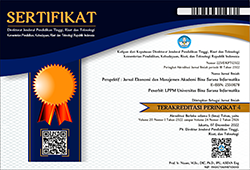E-PERFORMANCE SEBAGAI IMPLEMENTASI UMPAN BALIK 360 DERAJAT DALAM PELAKSANAAN PENILAIAN KINERJA PEGAWAI
Abstract
Abstract, The performance of the organization is determined by the performance of employees, whether small or large companies, private companies or government agencies, even organizations that are not profit oriented. Where with the performance of the organization will be able to encourage an organization or company to achieve goals and maintain the survival of the organization or perusahaan.Namun not infrequently many companies or organizations that have not been able to perform management and assessment of employee performance to achieve organizational performance. To assess employee performance, an organization needs to take measurements of their performance. Employee performance measurement is one way by applying e-performance done by using 360 degree method through 2 (two) stages. The first stage is performance appraisal through the Main Performance Index (IKU) component with a weighting rating of 60%. The second stage, a behavioral assessment performed with a rating weight of 40%. E-Performance awareness as a 360 degree performance appraisal implent will encourage employees to improve their performance in achieving organizational performance. With e-performance implementation will be capable of implementing a 360-degree and appraisal as feedback on employee performance will continue to improve as evaluated employees can see how work behaviors have been carried out from the perspective of other employees. So it can be said that e-performance in the 360 degree assessment is an approach to the objectivity of employee appraisal.
Keywords: E-performance, 360 degree feedback, Employee Performance
Abstrak , Kinerja organisasi sangat ditentukan oleh kinerja pegawai, baik itu perusahaan kecil atau besar, perusahaan swasta ataupun lembaga pemerintahan, bahkan organisasi yang tidak berorientasi profit. Dimana dengan kinerja organisasi akan mampu mendorong sebuah organisasi atau perusahaan untuk mencapai tujuan dan mempertahankan kelangsungan hidup organisasi atau perusahaan tersebut.Namun tidak jarang banyak perusahaan atau organisasi yang belum mampu untuk melakukan pengelolaan dan penilaian terhadap kinerja pegawai untuk mencapai kinerja organisasi. Untuk menilai kinerja pegawai, suatu organisasi perlu melakukan pengukuran atas kinerja mereka. Pengukuran kinerja pegawai salah satu cara dengan penerapan e-performance yang dilakukan dengan menggunakan metode 360 derajat melalui 2 (dua) tahap. Tahap pertama, penilaian kinerja melalui komponen Indeks Kinerja Utama (IKU) dengan bobot penilaian 60%. Tahap kedua, penilaian perilaku yang dilakukan dengan bobot penilaian 40%. Penerapam e-performance sebagai implementasi penilaian kinerja 360 derajat akan mendorong pegawai untuk dapat meningkatkan kinerjanya dalam mencapai kinerja organisasi. Dengan implementasi e-performance akan mampu memberikan umpan balik atau feedback atas kinerja pegawai sehingga akan terus meningkatkan kinerjanya karena pegawai yang dievaluasi dapat melihat bagaimana perilaku kerja yang telah dijalankan dari perspektif pegawai lain. Sehingga dapat dikatakan bahwa e-performance dalam penilaian 360 derajat merupakan suatu pendekatan menuju objektivitas penilaian pegawai.
Kata kunci : E-performance, Umpan balik 360 derajat, Kinerja Karyawan
Full Text:
PDFReferences
Bernardin, H.John and Russel. 2010. Human Resource Management. New York: McGraw-Hill
Bacal dan Robert (2012). Performance Management Terjemahan Surya Dharma dan Yanuar Irawan, Penerbit Gramedia Pustaka.
Furqon. (1999). Statistika Terapan Untuk Penelitian. Bandung: AFABETA.
Fleenor, J. W. (2008). Leveraging the impact of 360-degree feedback. Dalam J. W. Fleenor, Leveraging the impact of 360-degree feedback (hal. xvi). USA: Center for Creative Leadership
Hasibuan, M. S. P. (2011). Manajemen Sumber Daya Manusia. Jakarta: CV Haji Masagung.
http://www.pajak.go.id/content/buletin-kinerja-edisi-xiv2013
Mangkunegara, A. A. A. P. (2000). Manajemen Sumber Daya Manusia Perusahaan. Bandung: Remaja Rosdakarya.
Martilla, J. A., & James, J. C. (1977). Importance-Performance Analysis. Journal of Marketing, 41(1), 77–79. Retrieved from http://www.jstor.org/stable/1250495 .
Oktarinanda, A. (2012). Perbandingan Efisiensi Metode Least Trimmed Square (LTS) dan Metode Least Median Square (LMS) Dalam Estimasi Parameter Regresi Robust (Studi Kasus Data Produksi Padi Kabupaten / Kota di Jawa Timur 2012), 177–180.
Prawirosentono, S. (2008). Kebijakan Kinerja Pegawai. Yogyakarta: BPFE.
Sevilla, C. G. et. al. (2007). Research Methods. Quezon City: Rex Printing Company.
Solikhin. (2006). Analisis Pengaruh Motivasi Kerja Terhadap Kinerja Pegawai Negeri Sipil di Badan Kepegawaian Daerah Kabupaten Tegal.
Suliyanto. (2006). Metode Riset Bisnis. Yogyakarta: Andi.
Wibowo, 2007. Manajemen Kinerja. Jakarta:Murai Kencana.
DOI: https://doi.org/10.31294/jp.v16i2.4032
Copyright (c) 2018 Perspektif
dipublikasikan oleh LPPM Universitas Bina Sarana Informatika Jakarta
Jl. Kramat Raya No.98, Kwitang, Kec. Senen, Kota Jakarta Pusat, DKI Jakarta 10450

This work is licensed under a Creative Commons Attribution-ShareAlike 4.0 International License









